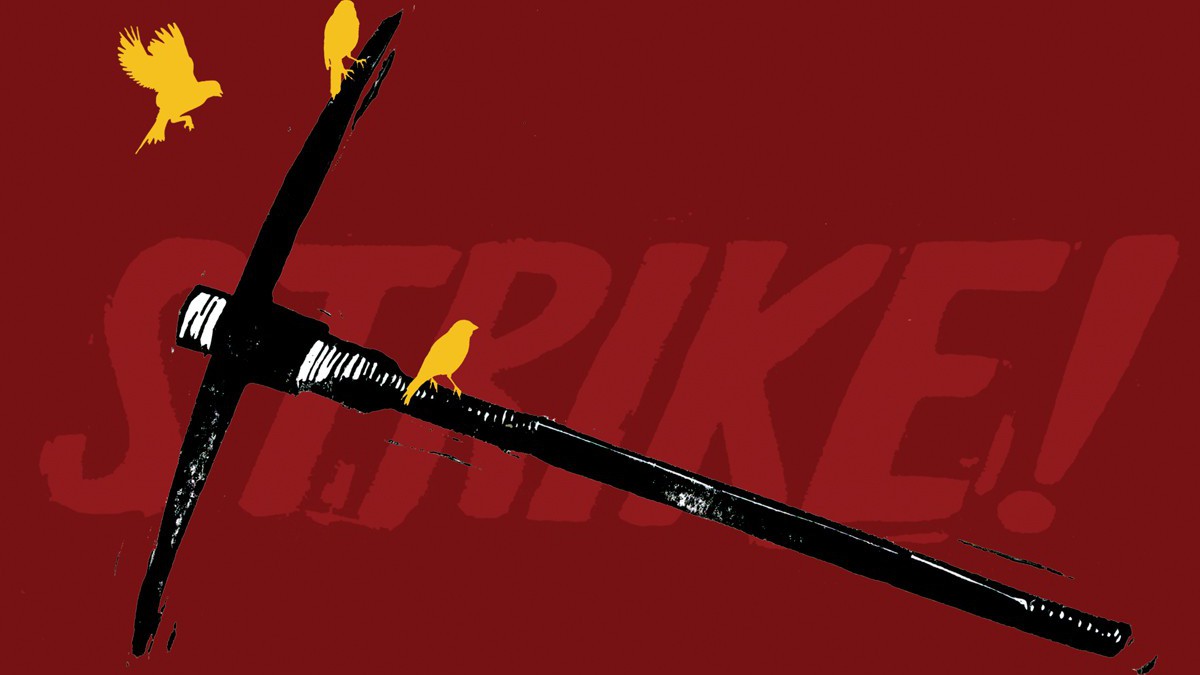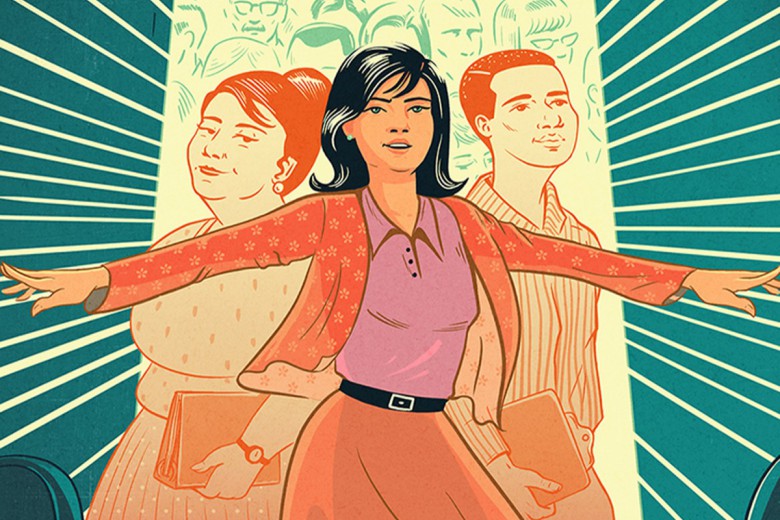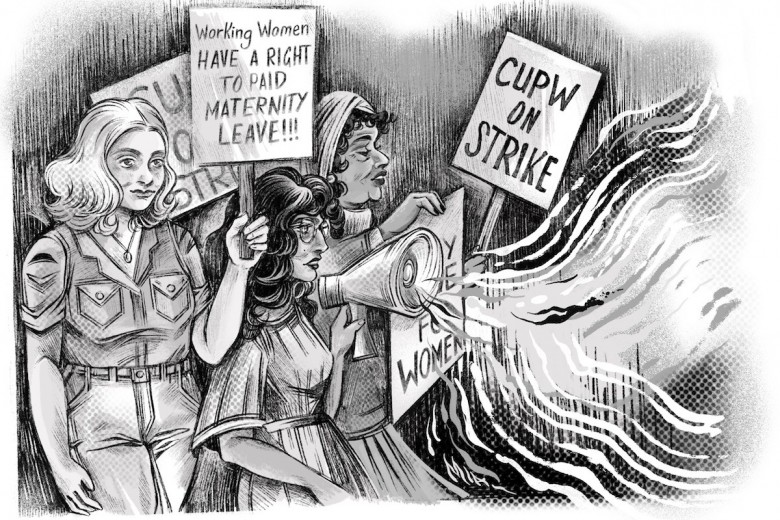Robert MacDonald was walking down a street in Drumheller, Alberta, on a summer Saturday evening in 1919 when he saw a group of men walking toward him. One of the men pointed at him and said to the others, “Here’s another One Big Union guy. Take him away.”
The men hustled MacDonald into a car and drove him to a barn outside of town where other local coal miners were also being dropped off. One man showed MacDonald his loaded shotgun. Another, pointing at a beam on the roof, told the captured coal miners, “We’re going to hang you on that beam.”
MacDonald was one of thousands of Drumheller coal miners who, two months earlier, had voted to join the radical and militant One Big Union (OBU) and strike for union recognition. The men who had grabbed him off the street were working for the bosses, and threatened to kill him for no other reason than that he was a worker on strike who had dared to walk down the street alone.
Drumheller’s disgrace
The swath of southern Alberta which included the Drumheller Valley was originally the home of mostly Niitsitapi, Assiniboine, and Tsuut’ina peoples, and became Treaty 7 territory in 1877. Mine owners in the Drumheller valley who began buying up parcels of coal-rich land in the early 20th century wanted to make money as quickly as possible. Bosses lured new immigrants from Europe to work in the valley with promises of company housing and good wages.
But when the workers arrived, they discovered overcrowded canvas tents infested with bedbugs. There were no medical facilities or clean drinking water, and diseases like typhoid spread like a prairie fire. The bosses grouped immigrant workers who spoke different languages on the same work teams to prevent them from organizing. Living conditions in the valley were so bad that soldiers returning from the First World War began calling Drumheller the “Western Front,” claiming that conditions in the valley’s mining towns were worse than those in the trenches.
Living conditions in the valley were so bad that soldiers returning from the First World War began calling Drumheller the “Western Front.”
A government inquiry into industrial relations concluded what miners in the Drumheller valley already knew – that the chief causes of labour unrest were “unemployment, the rising cost of living, long working hours, lack of collective bargaining rights, the housing shortage, restrictions on freedom of speech and the press, and unequal educational opportunities.”
But despite the appalling conditions in which these coal miners lived and worked, their trade union – the conservative and staid United Mine Workers of America (UMWA) – refused to organize or support any industrial action.
One big division
The Drumheller miners were not alone. Workers from British Columbia to Manitoba were increasingly dissatisfied with a splintered labour movement. The eastern provinces were dominated by conservative craft unions, where workers were organized according to their specific trade, while the West was led by militant industrial unions that encouraged organizing the entire working class.
The One Big Union was the result of this split. Prairie unions and federations held a special convention in Calgary on March 13, 1919. Delegates to this convention, including rank-and-file unionists, were overwhelmingly members of the Socialist Party of Canada, a revolutionary Marxist organization that favoured the abolition of the capitalist system. The OBU’s new constitution signalled a radical departure from the conservatism of eastern craft unions: “Modern industrial society is divided into two classes, those who possess and do not produce, and those who produce and do not possess. Alongside this main division all other classifications fade into insignificance. Between these two classes a continual struggle takes place.”
“Modern industrial society is divided into two classes, those who possess and do not produce, and those who produce and do not possess. Alongside this main division all other classifications fade into insignificance. Between these two classes a continual struggle takes place
Delegates also voted to endorse resolutions calling for the immediate withdrawal of Canadian troops fighting the Bolsheviks in the Soviet Union, freedom of speech and assembly, and for a general strike to take place on June 1, 1919, in support of demands for a six-hour workday. Unions and federations returned to their locals for a vote on whether to break their affiliation with their current international organization and join the OBU. Among them was District 18 – the Drumheller valley coal miners. Ninety-five per cent of coal miners in the valley voted in favour of leaving the UMWA to join the OBU.
One of the many reasons the OBU found success among the Drumheller miners was that workers resented paying their union dues to the UMWA head office in Indianapolis, since the UMWA distributed so few of those funds back to the valley. The valley’s miners were also opposed to the piecework system, where they were contracted and paid by the amount of coal they brought up, a system that allowed bosses to skimp miners on their wages. Workers demanded a salaried day rate. The UMWA, however, dug in its heels to support contract mining, and threatened to cut off union funds to the valley altogether if the Drumheller miners continued to agitate for a wage-based system.
The UMWA, however, dug in its heels to support contract mining, and threatened to cut off union funds to the valley altogether if the Drumheller miners continued to agitate for a wage-based system.
This threat was the breaking point for the Drumheller coal miners. The OBU only organized workers in western Canada – their dividing line was Port Arthur, now Thunder Bay – and the Drumheller miners believed that the OBU would keep union funds in the valley.
In 1919, miners in the Drumheller valley comprised about 17 per cent of Alberta’s coal mining workforce. Coal workers across southern Alberta voted overwhelmingly to leave their internationals and join the OBU. Coal miners in Canmore summed up Albertan workers’ general feeling toward the UMWA in a union bulletin note that read: “NEVER AGAIN SHALL WE RETURN TO THAT ROTTEN INTERNATIONAL.”
Strike!
The rush of organizing a new radical Canadian union electrified workers and inflamed industrial tensions. In mid May, 30,000 workers in Winnipeg abruptly walked off the job, sparking the Winnipeg General Strike. Strikers stopped trains and closed shops, gathering in the streets and creating informal strike committees to coordinate food delivery and public safety.
Coal miners in the valley were not to be outdone by their brothers and sisters in Winnipeg. District vice-president Phillip Christophers, who had pushed through the original convention resolution for a general strike, organized with other union members to leaflet the Drumheller valley. These posters and pamphlets urged workers to “get together as the Bosses have already done,” proposing that “the worker should receive the full product of his toil.”
On May 24, 1919, Drumheller miners walked out of the mines. This decision to strike came on the heels of the refusal of 13 mining companies in the Drumheller valley to recognize the OBU as the miners’ official bargaining agent – even though the union had overwhelmingly won the vote among miners in the valley.
Two years after the Bolsheviks seized power in Russia, the Canadian government feared these strikes were the prelude to revolution at home.
Two years after the Bolsheviks seized power in Russia, the Canadian government feared these strikes were the prelude to revolution at home. The House of Commons amended the Criminal Code to include Section 98, which allowed the government to prosecute members of “unlawful organizations” that advocated the “use of force.” Both categories were broadly defined, and the law was primarily used to prosecute communists and trade unions. Finally, on Bloody Saturday, Mounties on horseback attacked a mass demonstration protesting the arrest of Winnipeg General Strike leaders, killing two people and injuring at least 30.
Five days later, on June 25, the Winnipeg General Strike was over. But the Drumheller valley coal miners stayed on strike, continuing the struggle to establish the OBU on the Prairies. In response, coal operators received permission from the Northwest Mounted Police to hire “special constables” – unemployed First World War veterans who were paid $10 a day (a substantial amount at the time), plied with free liquor, and armed with brass knuckles and crowbars.
At the time, Hungarian, Ukrainian, and Italian workers were considered “enemy aliens,” stealing jobs that rightfully belonged to returning veterans. Coal company owners mobilized this anti-immigrant sentiment to create a powerful strikebreaking militia.
Workers who refused to break the strike, like Robert MacDonald and Thomas Patterson Thomas, were captured by special constables and given a ride about 65 kilometres out of the valley, beaten badly, and left to find their own way home. Many miners given this treatment never returned to the valley, opting instead to hitch a ride at the nearest train station and find their fortunes elsewhere. Strikers found safety in numbers, forming self-defence militias that deterred the constables from attacking.
Coal company owners mobilized this anti-immigrant sentiment to create a powerful strikebreaking militia.
Miners were even attacked in their homes. Phillip Christophers was kidnapped from his home and taken to a hall in Drumheller, where local mine owners, real estate agents, and bankers demanded he renounce the OBU. Christophers and other local leaders were questioned for hours, but refused to denounce the union. The next morning, they were run out of town at gunpoint by a squad of special constables.
Coal companies also persuaded the government to declare the OBU an “unlawful organization” under Section 98. In August of 1919, two strike leaders were beaten, tied to telephone poles, and tarred and feathered. This final act of violence ended the Drumheller coal strike.
Until the bitter end
Workers had not given up on the OBU, despite being beaten by the combined forces of the state, the bosses, their former conservative trade unions, and the special constables. “No one,” Christophers had said, “is going to dictate to the men what labour organization they will belong to.”
Miners in the district continued to carry OBU union cards even after the strike’s termination. To rout the OBU from the valley, coal operators cosied up with the UMWA, but the OBU remained firmly in control of the union paper, the OBU Bulletin, and frequently called general meetings where everyone was invited – “even the bosses if they dare.”
Despite the strike’s defeat, the mere threat of militant industrial action allowed coal miners in Alberta to achieve massive gains. The miners’ day rate rose from $5.70 to $7.50 between 1919 and 1920, even after the strike had collapsed, and the rate remained well above inflation for a few years.
“No one,” Christophers had said, “is going to dictate to the men what labour organization they will belong to.”
Membership in the OBU slowly eroded throughout the 1920s. Employers refused to bargain with OBU representatives, and coal operators in the valley would only negotiate with the UMWA, which relished the opportunity to sideline its competitor. OBU organizers were frequently kidnapped, beaten, and blacklisted.
With the decline of the OBU, coal company owners took advantage of the weakened UMWA to claw back the gains won during the 1919 strike. Salaries in the valley first took a dip in 1924, and by 1925 the miners were making less than they had when the strike began. In the absence of any widespread industrial action, the coal miners’ day rate would not again reach its 1919 level until 1944.
Drumheller today
The 1919 Drumheller coal strike ended in defeat. Coal miners were beaten and abandoned, beset on every side by enemies. Their investment in the OBU was based on the belief that the working class could wrest control of society from the capitalist class by building up economic control industry by industry, laying the foundation for a socialist reconstruction of society through general action.
It is easy to romanticize trade union struggles of the past, and hard to build these movements in our own time. Today’s low unionization rates, reinforced by a hundred years of legislation aimed at eroding trade union power, make the 1919 Drumheller coal strike seem far-fetched. But knowing the radical history of the labour movement entails more than nostalgia. If we remember the history of the Prairies as the history of the wealthy and powerful, we diminish our own ability to take action against exploitation and poverty today.
Trade unions can and must be more than a bureaucracy of hackneyed norms, whose loftiest goals are to blunt the ceaseless attacks on the working class. The rise of the OBU shows that trade unions and their most powerful weapon – the strike – can be an expression of power in the hands of the worker, with their aims set not on making small adjustments to exploitation, but on winning a new world.







